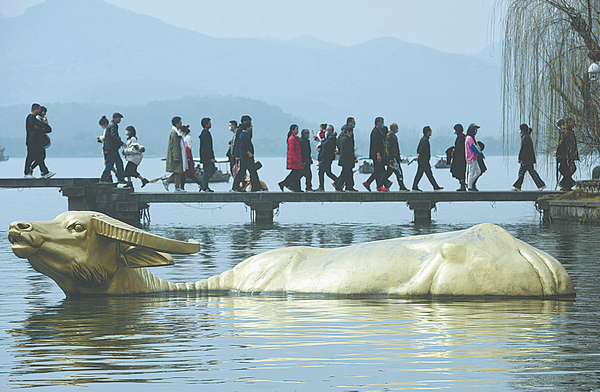

SHANGHAI-China saw a robust recovery in its tourism sector during the Spring Festival holiday, as both urban and rural residents found new destinations for their travels.
Approximately 251 million domestic trips were made during the holiday, which ran from Jan 31 to Feb 6, generating tourism revenue of 289.2 billion yuan (about $45.8 billion), according to the Ministry of Culture and Tourism. The two figures respectively recovered to 73.9 percent and 56.3 percent of the levels seen in the same holiday of 2019, before the COVID-19 pandemic.
"The tourism market performed better than expected," says Dai Bin, head of the China Tourism Academy.
China's domestic tourism market continued to rebound during the holiday, with people seeking higher-quality tourism and leisure activities and more consumers in lower-tier cities and rural areas entering the market, according to Dai.
Tourists from rural areas accounted for 38.1 percent of all domestic tourists during the holiday, a new record, official data shows.
The demand for tourism from rural residents and the elderly is becoming a new driving force for the innovative development of the country's tourism industry, Dai says.
More people chose to experience new scenery and tourism products during the Spring Festival holiday. New vacation options, including ice and snow tourism, short-distance travel and cultural tourism, not only brought people more fun but also helped heat up the tourism market.
The Beijing 2022 Olympic Winter Games, which opened during the Spring Festival holiday, fueled the growth of the ice and snow industry.
According to the online platform Tongcheng Travel, the order volume for snow and ice tourism destinations during the Lunar New Year holiday jumped 68 percent from a year ago.
According to Trip.com Group, the order volume for skiing activities grew 33 percent year-on-year over the first three days of the holiday, and cities with abundant winter sports activities in the south, such as Shanghai and Guangzhou, also joined the list of popular destinations for the sector.
Short-distance travel was a popular choice during the Spring Festival holiday.
Fang Zeqian from Trip.com Group says that over 80 percent of tourists chose to travel locally. On the Trip.com Group platform, bookings for local tourist attractions and hotels respectively accounted for approximately 82 percent and 60 percent of all orders.
Shanghai, Nanjing and Hangzhou were among the most popular tourist destinations and also major sources of tourists over the holiday, according to Tongcheng Travel.
There was surging demand for hotels providing specialized entertainment such as esports, with orders for esports rooms during the holiday increasing over 80 percent, Trip.com Group says.
According to the China Tourism Academy, 91.4 percent of all tourists experienced cultural tourism during the holiday, and 81.8 percent took part in more than two cultural activities. Most tourists chose to visit museums and art galleries.
Shanghai received nearly 11 million visitors and raked in over 17.7 billion yuan during this year's Spring Festival holiday, with approximately 500 cultural and tourism activities themed around intangible cultural heritage.
Xinhua